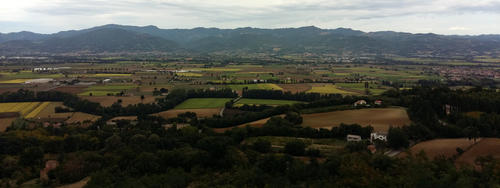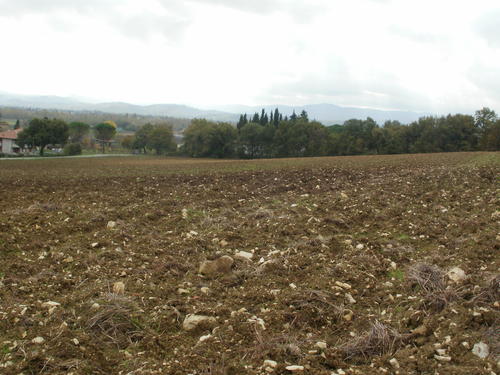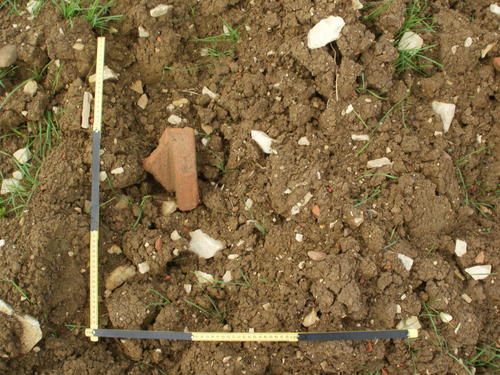Upper Tiber Valley Survey
The Upper Tiber Valley Survey is conducted in Collaboration with the Soprintendenza Archeologia dell’Umbria (Dott.ssa Marisa Scarpignato) and the Soprintenza Archeologia della Toscana (Dr. M. Bueno).
Fig. 1. View of the Upper Tiber Valley from Citerna.
Bildquelle: Silvia Polla
Fig. 2. Ploughed fields.
Bildquelle: Silvia Polla
Fig. 3. Surface artefact scatters.
Bildquelle: Silvia Polla
While the systematic approach to the rural landscapes of the Lower and Middle Tiber Valley has enormously contributed to the better understanding of settlement and economy in this key-region (see Di Giuseppe et al. 2002; Patterson 2004; Patterson et al. 2004; Di Giuseppe 2005 and 2005a; Coarelli, Patterson 2008), a comprehensive and systematic study of the rural landscape in the Upper Tiber Valley is still lacking.
In order to fill this gap, an integrated non-destructive fieldwork methodology will be applied in the new established “Upper Tiber Valley Survey” (2015- ). The study area is located in modern day Eastern Tuscany and Northern Umbria, in a historically very relevant region between Etruria and Umbria, which starting from the Republican time and over the “Romanization” process experienced strong economic growth, mainly related to wine production for supplying Rome. The related intensification of agriculture is witnessed by a centuriated landscape (Camerieri, Mattioli 2014) as well as by written sources on land redistribution. The regional settlement pattern is characterized by the spreading of villae on the river valley foothills and of productive farms distributed in the alluvial plain (Braconi 2008). Despite of the cultural and economic centrality of the area very little systematic research has been conducted (Coarelli, Patterson 2008; Scortecci 2014) apart from the extensive excavation of the so-called villa in Tuscis of Plinius the Younger (Braconi 2007).
The main aim of the “Upper Tiber Valley Survey” is to collect systematic information on rural settlement histories and economies. This regional record will have strong impact on the understanding of Romanization processes, Roman agriculture, socio-economic change during the Republican and Imperial period and the development of the villa system in central Italy (Hekster et al. 2007; Terrenato 2012; Bowman, Wilson 2013; Witcher 2013).
For this purpose, legacy data from previous topographic research and surveys (Tagliaferri 1991; ASAT 1992; Giontella 2008; Laurenzi 2010; Scortecci 2014) have been re-considered (first campaign 2015), and sampling areas of the ager tifernus - the territory of the municipium Tifernum Tiberinum (today Città di Castello) – have been identified for intensive fieldwalk aiming at total coverage artefact survey in ploughed fields. Combining intensive ceramics survey at different scale, remote sensing technologies and geophysical prospections on test-sites, the project aims at dealing with the gap between sites typologies (i.e. villa vs farm) and the spatial and economic relation between rural sites, considering several indicators and including as well the space between the sites (Campana 2011). Taking into consideration the debate on the interpretation and meaningful use of archaeological surface scatters for the definition of rural settlement patterns and regional demographic trends (recently de Haas 2011; Launaro 2011; Attema, Schörner 2012; Tol 2012; Witcher 2012), the main task concerns the generation of new spatial datasets encompassing different indicators for a more nuanced understanding of rural sites. Based on the collected dataset, a selected sample of sites will be considered in a second stage for detailed methodological comparative analysis integrating geophysical prospections for the assessing of sites typologies in relation to the post-depositional surface record. Integrating geophysical survey techniques will allow comparison of the surface indicators to variables like settlement extension and organization for enhancing the interpretative potential of survey scatters. The detailed study of the surface assemblages of ceramic material circulating in the Upper Tiber Valley during the Republican and Early Imperial period will provide relevant chronological and socio-economic insights on Romanization process, regional economic integration and regional consumption and supplying patterns. The potential of the study and better definition of regional common wares will be exploited, as recently a better knowledge of common wares allows an important chronological refinement with strong implication on the study of settlement history and demographic reconstructions (Launaro 2011). Moreover, we will pay attention to the regional dynamics of ceramic production (Salvini, Lelli 2011) and circulation in urban (Scarpignato 2004) and rural context during the Late Imperial/Late Antique period for getting new insights on the continuity and scale of the local economic networks.
The Upper Tiber Valley Survey is conducted in Collaboration with the Soprintendenza Archeologia dell’Umbria (Dott.ssa Marisa Scarpignato) and the Soprintenza Archeologia della Toscana (Dr. M. Bueno).
Selected Bibliography
AA.VV. (1983), Ville e insediamenti rustici di età romana in Umbria, Perugia, 1983
ASAT (1992), Atlante dei Siti Archeologici della Toscana, Roma
Attema P., Schörner G. (2012), Comparative Issues in the Archaeology of the Roman Ru-ral Landscape: Site Classification between Survey, Excavation and Historical Categories. Suppl. JRA, Portsmouth
Bowman, A.K. and Wilson, A.I. (2013) The Roman agricultural economy: organisation, investment and production. Oxford studies on the Roman economy (3). Oxford University Press, Oxford
Braconi P. (2007), La Villa di Plinio a San Giustino, L'Orientale Editrice, Napoli
Braconi P. (2008), Territorio e paesaggio dell'alta valle del Tevere in età romana, in Coarelli, Patterson 2008, 87-104
Camerieri P., Mattioli T., Il paesaggio centuriato di Tifernum Tiberinum e Perusia: prime considerazioni, in Scortecci 2014
Campana S. (2011), Geofisica estensiva e continua. Verso un nuovo livello analitico per l’archeologia? AAerea IV.2010 -V.2011, 239 - 250
Coarelli F., Patterson H. (2008), Mercator placidissimus. The Tiber Valley in Antiquity. New research in the upper and middle river valley, Atti del Convegno, Roma, British School at Rome, 27-28 febbraio 2004, Quasar, Roma
de Haas T. C. A. (2011), Fields, Farms and Colonists: Intensive Field Survey and Early Roman Colonization in the Pontine Region, Central Italy (2 vols.). Groningen archaeological studies, 15, Groningen University Library
Di Giuseppe et al. (2002), di Giuseppe H., Sansoni M., Williams J. and Witcher R., The Sabinensis Ager Revisited: A Field Survey in the Sabina Tiberina, in Papers of the British School at Rome Vol. 70, 99-149
Di Giuseppe H. (2005), Un confronto tra l’Etruria settentrionale e meridionale dal punto di vista della ceramica a vernice nera, Papers of the British School at Rome (73), 31-84
Di Giuseppe H., (2005a), Realtà micro-regionali a confronto sulle due sponde del Tevere tra l’età arcaica e repubblicana. In Attema P., Nijboer A.J., Zifferero A., a cura di, Papers in Italian Archaeology VI. Community and Settlements from the Neolithic to the Early Medieval Period. Proceedings of the 6th Conference of Italian Archaeology, Groeningen, April 15 – 17th 2003. BAR International Series 1452 (I)
Diringer D., Foglio 115, Città di Castello, Firenze 1930
Giontella C. (2008), Una ricerca di superficie nell'alta valle del Tevere: le evidenze archeologiche di un'area al confine tra Umbri ed Etruschi, in Coarelli, Patterson (2008), 363-370
Hekster O., de Kleijn G., Slootjes D. (2007), Crises and the Roman Empire, Proceedings of the Seventh Workshop of the International Network Impact of Empire (Nijmegen, June 20-24, 2006), Brill, Leiden
Launaro A. (2011), Peasants and Slaves. The Rural Population of Roman Italy (200 BC to AD 100). Cambridge
Laurenzi G. P. (2010), Una chiave di lettura delle origini di Sansepolcro attraverso lo studio dei materiali raccolti dal Gruppo Ricerche Archeologiche Sansepolcro, in Czortek A. (ed.), La Nostra Storia, Lezioni sulla Storia di Sansepolcro, Antichitá e Medioevo, 59- 143
Patterson et al. (2004), Patterson H., Di Giuseppe H., Witcher R., Three Southetrurian “crises”: first results of the Tiber Valley Project, Papers of the British School at Rome (74), 1- 36
Patterson, H. (2004), Bridging the Tiber. Approaches to Regional Archaeology in the Middle Tiber Valley. Archaeological Monograph of the British School at Rome, 13. London, British School at Rome
Salvini M., Lelli P., Monterchi (AR). Le fornaci di Catiglianello in NS 7, 2011, 309- 314
Scarpignato, M., Bolli laterizi dal territorio di Tifernum Tiberinum, Epigraphica LX, 1998, 260-266
Scarpignato M., a cura di, Alle radici della città. Testimonianze archeologiche di Tifernum Tiberinum, Città di Castello, 2004
Scortecci D. (2014), a cura di, La Media e Alta Valle del Tevere dall’Antichità al Medioevo, Atti della Giornata di Studio (Umbertide, 26 maggio 2012), Daidalos, Umbertide
Tagliaferri A. (1991), Romani e non Romani nell’Alta Valtiberina. Da una ricerca archeologica “di superficie”, Udine, Del Bianco Editore
Terrenato, N. (2012), The essential countryside. The Roman world, in Alcock S., Osborne R. (eds.), Classical archaeology. Rev. 2d ed., Blackwell, Oxford, 144–167
G. W. Tol (2012), A Fragmented History: A Methodological and Artefactual Approach to the Study of Ancient Settlement in the Territories of Satricum and Antium, Groningen Archaeological Studies 18
Witcher R. (2012), That from a long way off look like farms: The classification of Roman rural sites, in Attema, Schörner 2012, 11-30



